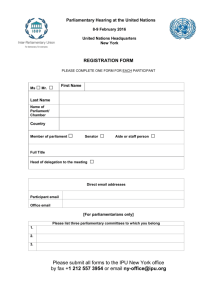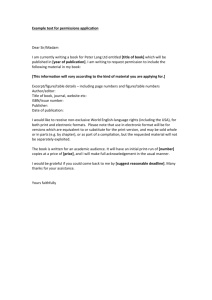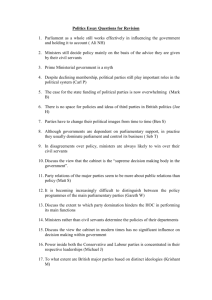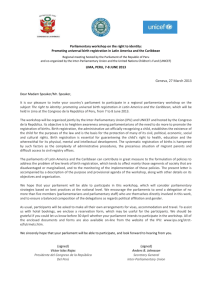Social Media: An Introduction
advertisement
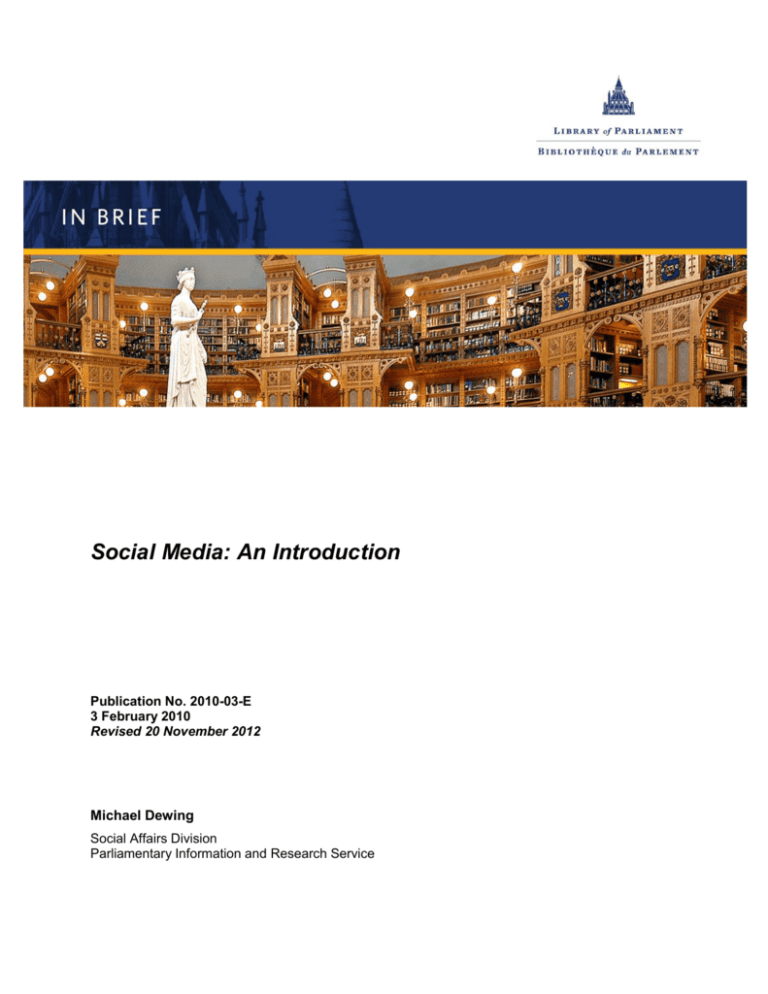
Social Media: An Introduction Publication No. 2010-03-E 3 February 2010 Revised 20 November 2012 Michael Dewing Social Affairs Division Parliamentary Information and Research Service Social Media: An Introduction (In Brief) HTML and PDF versions of this publication are available on IntraParl (the parliamentary intranet) and on the Parliament of Canada website. In the electronic versions, a number of the endnote entries contain hyperlinks to referenced resources. Ce document est également publié en français. Papers in the Library of Parliament’s In Brief series are short briefings on current issues. At times, they may serve as overviews, referring readers to more substantive sources published on the same topic. They are prepared by the Parliamentary Information and Research Service, which carries out research for and provides information and analysis to parliamentarians and Senate and House of Commons committees and parliamentary associations in an objective, impartial manner. Publication No. 2010-03-E Ottawa, Canada, Library of Parliament (2012) CONTENTS 1 INTRODUCTION ....................................................................................................... 1 2 WHAT ARE SOCIAL MEDIA? ................................................................................... 1 3 THE EVOLUTION OF SOCIAL MEDIA ..................................................................... 2 4 ATTRIBUTES OF SOCIAL MEDIA ........................................................................... 2 5 THE IMPACT OF SOCIAL MEDIA ............................................................................ 3 6 CONCLUSION .......................................................................................................... 3 LIBRARY OF PARLIAMENT i PUBLICATION NO. 2010-03-E SOCIAL MEDIA: AN INTRODUCTION 1 INTRODUCTION Just as the Internet has changed the way Canadians buy music, organize vacations, and research school projects, it has also affected how they interact socially. Through the use of social media, people can exchange photos and videos, share news stories, post their thoughts on blogs, and participate in online discussions. Social media also allow individuals, companies, organizations, governments, and parliamentarians to interact with large numbers of people. In conjunction with the increase in online activity, there are concerns about the ways in which the personal information that is shared by social media users may be collected and analyzed. This paper gives a brief overview of the evolution and development of social media, looks at how their attributes affect the way people interact online, and considers their potential social and economic impact. 2 WHAT ARE SOCIAL MEDIA? The term “social media” refers to the wide range of Internet-based and mobile services that allow users to participate in online exchanges, contribute user-created content, or join online communities. The kinds of Internet services commonly associated with social media (sometimes referred to as “Web 2.0”) include the following:1 Blogs. Short for “web log,” a blog is an online journal in which pages are usually displayed in reverse chronological order.2 Blogs can be hosted for free on websites such as WordPress, Tumblr and Blogger.3 Wikis. A wiki is “a collective website where any participant is allowed to modify any page or create a new page using her Web browser.” 4 One well-known example is Wikipedia,5 a free online encyclopedia that makes use of wiki technology. Social bookmarking. Social bookmarking sites allow users to organize and share links to websites. Examples include reddit, StumbleUpon and Digg.6 Social network sites. These have been defined as “web-based services that allow individuals to (1) construct a public or semi-public profile within a bounded system, (2) articulate a list of other users with whom they share a connection, and (3) view and traverse their list of connections and those made by others within the system.” 7 Among the most popular in Canada are Facebook and LinkedIn.8 Status-update services. Also known as microblogging services, status-update services such as Twitter9 allow people to share short updates about people or events and to see updates created by others.10 LIBRARY OF PARLIAMENT 1 PUBLICATION NO. 2010-03-E SOCIAL MEDIA: AN INTRODUCTION Virtual world content. These sites offer game-like virtual environments in which users interact. One example is the imaginary world constructed in Second Life,11 in which users create avatars (a virtual representation of the user) that interact with others.12 Media-sharing sites. These sites allow users to post videos or photographs. Popular examples include YouTube, Pinterest and Instagram.13 These categories overlap to some degree. Twitter, for example, is a social network site as well as a status-update service. Likewise, users of the social network site Facebook can share photographs, and users of the media-sharing site Pinterest can follow other people. 3 THE EVOLUTION OF SOCIAL MEDIA In the late 1990s, as broadband14 Internet became more popular, websites that allowed users to create and upload content began to appear.15 The first social network site (SixDegrees.com) appeared in 1997. From 2002 onward, a large number of social network sites were launched. Some – such as Friendster – enjoyed a surge of popularity, only to fade. Others developed niche communities: MySpace, for example, appealed to teenaged music aficionados.16 By the late 2000s, social media had gained widespread acceptance and some services gained huge numbers of users. For example, in November 2012, Facebook announced it had 1 billion users worldwide, of whom 18 million were in Canada.17 In July 2012, Twitter had an estimated 517 million users, of whom 10 million were in Canada.18 A number of factors have contributed to this rapid growth in social media participation. These include technological factors such as increased broadband availability, the improvement of software tools, and the development of more powerful computers and mobile devices; social factors such as the rapid uptake of social media by younger age groups; and economic factors such as the increasing affordability of computers and software, and growing commercial interest in social media sites.19 4 ATTRIBUTES OF SOCIAL MEDIA With attributes that can affect the way people interact online, social media open up new ways for collaboration and discussion. One of these is persistence, meaning that a great deal of content posted on social media sites may remain there permanently by default. Other characteristics are replicability (content can be copied and shared) and searchability (content can be found easily using online search tools). The characteristic of accessibility is also important: social media can be used anywhere, at any time, where an Internet connection is available. LIBRARY OF PARLIAMENT 2 PUBLICATION NO. 2010-03-E SOCIAL MEDIA: AN INTRODUCTION These attributes shape the dynamics of social interaction online. For example, the “invisibility” of the reader raises questions about the context, appropriateness and even comprehensibility of a communication.20 Moreover, just as it is difficult to know who might be reading content posted on a social media site, the identity and motives of those who post content are not always clear. For example, there have been instances of companies using social media to market products through fake blogs or sponsored postings on social media sites.21 5 THE IMPACT OF SOCIAL MEDIA How is Canadian society affected by social media? Because the widespread adoption of these modes of communication began only in the early 2000s, their social and economic implications are not yet fully understood. Some believe the Internet is making people more isolated, while others hope it will increase democratic participation. Research by Statistics Canada suggests “that we should expect neither a dysfunctional society of loners nor a blissful society of happy networkers. Rather, we are facing a society that is differently cohesive from the one we have known.” 22 There do not appear to be any significant differences in the number of social ties or in the amount of social interaction between Internet users and non-users.23 Instead, the Internet is providing ways of fostering participation with community members and enhancing relationships, including through social media.24 Social media have also had an economic impact with respect to the ways in which content is created and consumed, and hence on the information and communications technologies sector.25 Indeed, in Canada, annual growth in this sector averaged 3.8% from 2002 to 2011, double the rate of growth in the overall economy (1.9%).26 In addition, many businesses are incorporating social media into their marketing strategies. For governments and parliamentarians, social media offer new ways to engage with citizens. To give an example, the Public Health Agency of Canada uses a variety of social media tools to share information about public health issues.27 As well, an increasing number of parliamentarians are using social media sites. 6 CONCLUSION For a growing number of Canadians, social media provide a way of keeping in touch with friends, relatives and communities. Social media also allow companies, organizations, governments and parliamentarians to reach large numbers of people. At the same time, social media are changing the ways in which people interact with others, although the full impact of these changes is not yet clear. The implications of sharing personal information are also not fully understood. Other papers in this Library of Parliament series take a closer look at social media with respect to demographics, privacy issues and political applications. LIBRARY OF PARLIAMENT 3 PUBLICATION NO. 2010-03-E SOCIAL MEDIA: AN INTRODUCTION NOTES This paper was originally part of a series on social media prepared by the Parliamentary Information and Research Service of the Library of Parliament. The following papers were also in the series: Michael Dewing, Social Media: Who Uses Them?, Publication no. 2010-05-E, revised 20 November 2012; Alysia Davies, Social Media: 3. Privacy and the Facebook Example, Publication no. 2010-06-E, 8 February 2010 [archived]; Amanda Clarke, Social Media: 4. Political Uses and Implications for Representative Democracy, Publication no. 2010-10-E, 22 March 2010; and Havi Echenberg, Social Media: 5. Parliamentary Use in the United Kingdom, Publication no. 2010-11-E, 25 March 2010 [archived]. Finally, the reader is invited to read an additional paper related to social media: Marie-Claude Langlois, Social Media and Job Searching Among Young Canadian Workers: A Summary of Government Initiatives, Publication no. 2012-44-E, 26 July 2012. 1. The sites mentioned are on the “Top Sites in Canada” list found on the Alexa website. 2. Organisation for Economic Co-operation and Development [OECD], “Participative Web and User-Created Content: Web 2.0, Wikis and Social Networking,” 2007, p. 36. 3. See the WordPress, tumblr and Blogger websites. 4. Alain Désilets and Sébastien Paquet, “Wiki as a Tool for Web-based Collaborative Story Telling in Primary School: a Case Study,” National Research Council of Canada, 2005. 5. See the Wikipedia website. 6. See the reddit, StumbleUpon and Digg websites. 7. Danah M. Boyd and Nicole B. Ellison, “Social Network Sites: Definition, History, and Scholarship,” Journal of Computer-Mediated Communication, Vol. 13, No. 1, 2007, article 11. 8. See the Facebook, and LinkedIn websites. 9. See the Twitter website. 10. Susannah Fox, Kathryn Zickuhr and Aaron Smith, “Twitter and Status Updating, Fall 2009,” Pew Internet & American Life Project, 21 October 2009. 11. See the Second Life website. 12. OECD (2007), p. 38. 13. See the YouTube, Pinterest and Instagram websites. 14. The Canadian Radio-television and Telecommunications Commission defines broadband as “[a]n always-on, high-speed connection to the Internet through the facilities of an ISP [Internet service provider].” CRTC Glossary, 15 May 2009. 15. OECD (2007), p. 27. 16. Boyd and Ellison (2007). 17. “Facebook tops 1 billion users,” CBC News, 4 October 2012. 18. Knowlton Thomas, “Twitter Passes 500 Million Users, Study Reveals; Canada Accounts for 2% of All Users,” TechVibes, 30 July 2012. 19. OECD (2007), p. 28. 20. Danah Boyd, “Social Media is Here to Stay … Now What?” Lecture notes, Microsoft Research Tech Fest, Redmond, Washington, DC, 26 February 2009. 21. David Gelles, “Blogs that spin a web of deception,” The Financial Times, 12 February 2009. LIBRARY OF PARLIAMENT 4 PUBLICATION NO. 2010-03-E SOCIAL MEDIA: AN INTRODUCTION 22. B. Veenhof et al., “How Canadians’ Use of the Internet Affects Social Life and Civic Participation,” Connectedness Series, Statistics Canada, Cat. no. 56F0004M, No. 16, December 2008, p. 22. 23. Ibid., p. 12. 24. Ibid., p. 20. 25. OECD (2007), p. 55. 26. Industry Canada, Information and Communications Technologies (ICT) Branch, “Canadian ICT Sector Profile,” May 2012, p. 2. 27. See Public Health Agency of Canada, “Stay informed, stay connected!” LIBRARY OF PARLIAMENT 5 PUBLICATION NO. 2010-03-E
